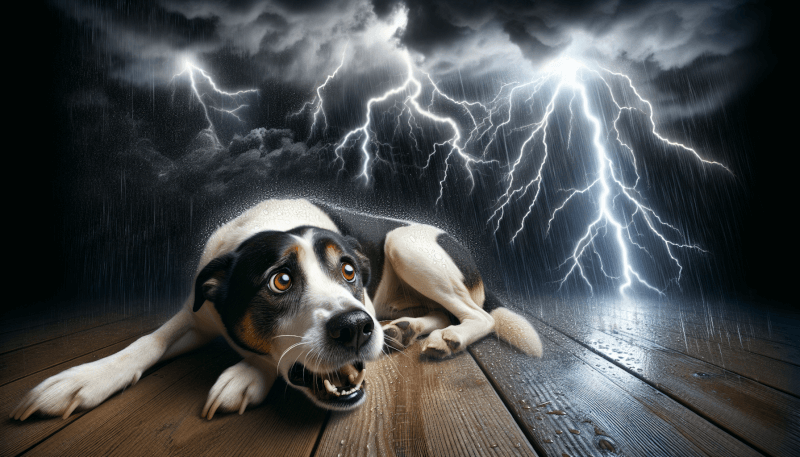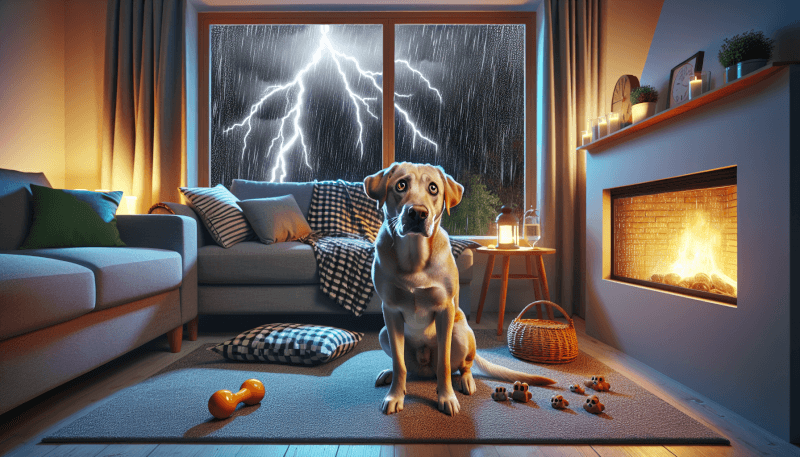If your furry friend trembles and hides at the sound of thunder, you are not alone. Many dogs experience fear and anxiety during thunderstorms, leaving their owners feeling helpless. But fear not, for there are steps you can take to help your four-legged companion cope with their thunderstorm phobia. From creating a safe space to trying anxiety-reducing techniques, this article will guide you in supporting your dog through their fear of thunder. Don’t let thunderstorms put a damper on your dog’s happiness – read on to discover how you can help them weather the storm.

Understanding Thunder Phobia in Dogs
For many dogs, thunderstorms can be a source of fear and anxiety. Thunder phobia, also known as astraphobia, is a common condition that affects dogs of all breeds and sizes. It is important as a responsible dog owner to understand the symptoms and causes of thunder phobia in order to help alleviate your furry friend’s distress.
Ready for Cat Trivia?
Test your knowledge about cats!

Recognizing the Symptoms of Thunder Phobia
Dogs experiencing thunder phobia may display a variety of symptoms, which can manifest both physically and behaviorally. Physically, your dog may tremble, pant excessively, drool, or pace around the room. They may also show signs of restlessness, attempt to hide in small spaces, or seek comfort from their owners. Some dogs even exhibit destructive behavior or try to escape during thunderstorms. Keep an eye out for these signs during storms to determine if your dog is suffering from thunder phobia.
Causes of Thunder Phobia
The exact cause of thunder phobia in dogs is not fully understood, but there are several theories as to why dogs develop this fear. It is believed that some dogs may have a genetic predisposition to anxiety or an increased sensitivity to loud noises. Traumatic experiences, such as being caught in a severe thunderstorm or being exposed to loud noises at a young age, can also contribute to the development of thunder phobia. Understanding the potential causes can help you address the issue more effectively.
Creating a Safe Environment
Creating a safe environment for your dog during thunderstorms is essential in managing their fear and anxiety. By designating a safe haven and using calming techniques, you can help your dog feel more secure.
Designating a Safe Haven
Identify a quiet, enclosed space in your home where your dog can retreat to during thunderstorms. This could be a cozy corner in a room or a crate covered with a blanket to create a den-like atmosphere. Make this space comfortable by adding soft bedding and familiar items, such as favorite toys or blankets. Introduce your dog to this safe haven in a positive and calm manner, and ensure that they associate it with feelings of security.
Using White Noise or Music
Playing white noise or calming music can help drown out the sound of thunder and create a soothing atmosphere for your dog. Choose classical music or specially designed calming playlists for dogs to help relax their nerves. These sounds can provide a sense of reassurance and help distract your dog from the thunderstorm outside.
Using Thundershirts
Thundershirts are specially designed garments that apply gentle pressure to your dog’s body, similar to a swaddling sensation. The pressure from the Thundershirt can have a calming effect on dogs, reducing their anxiety during thunderstorms. Many dog owners have reported positive results from using Thundershirts, so it may be worth considering as an additional tool to alleviate your dog’s thunder phobia.

Desensitizing Your Dog to Thunder
Desensitization involves gradually exposing your dog to the sound of thunder in a controlled and positive manner. This process aims to reduce your dog’s fear response to thunderstorms over time.
Gradual Exposure to Thunder Sounds
Start by playing a recording of thunder at a very low volume while engaging your dog in a positive activity, such as playing or giving treats. Gradually increase the volume over multiple sessions, ensuring that your dog remains relaxed and comfortable throughout. Repeat this process consistently and at regular intervals, gradually exposing your dog to louder thunder sounds. Over time, your dog should become less reactive to the actual sound of thunder.
Counterconditioning
Counterconditioning involves associating the sound of thunder with positive experiences. Whenever you anticipate a thunderstorm, engage your dog in activities that they enjoy and reward them with treats or praise. This positive reinforcement can help create a new and positive association with thunder, gradually reducing their fear response. Remember to be patient and consistent in your efforts to countercondition your dog to thunder.
Seeking Professional Help
If your dog’s thunder phobia persists or worsens despite your best efforts, it may be beneficial to seek professional help from a veterinarian or a professional dog trainer experienced in dealing with fear and anxiety issues.
Consulting a Veterinarian
A veterinarian can assess your dog’s health and behavior to determine the most appropriate course of action. They may suggest behavior modification techniques, prescribe anti-anxiety medications if necessary, or recommend consulting a certified professional dog trainer. A veterinarian’s expertise is invaluable in finding the best solution for your dog’s specific needs.
Working with a Professional Dog Trainer
A professional dog trainer who specializes in fear and anxiety issues can provide guidance and structured training programs to help your dog overcome their fear of thunder. They will assess your dog’s behavior, develop a personalized training plan, and provide ongoing support. With their expertise and experience, a professional dog trainer can make a significant difference in your dog’s quality of life during thunderstorms.

Dealing with Immediate Anxiety
During a thunderstorm, it is important to provide comfort and reassurance to your dog. By offering a sense of security and diverting their attention, you can help alleviate immediate anxiety.
Providing Comfort and Reassurance
Your presence can be a source of comfort for your dog during a thunderstorm. Stay calm and try to display a confident and relaxed attitude. Comfort your dog by gently petting them, speaking in a soothing voice, or simply sitting next to them. Avoid rewarding fearful behavior with excessive attention, as this may reinforce their anxiety.
Distracting and Diverting Attention
Engage your dog in activities or games that can divert their attention away from the thunderstorm. Play with their favorite toy, practice basic obedience commands, or offer puzzle toys filled with treats. By redirecting their focus onto positive activities, you can help shift their attention away from their fear of thunder.
Preventing Thunder Phobia
Taking proactive steps in preventing thunder phobia can be beneficial, especially in puppies or young dogs. Early socialization and positive reinforcement training can help build their confidence and resilience.
Early Socialization and Habituation
Expose your puppy or young dog to a variety of sounds, including thunderstorm simulations, during their early developmental stages. Gradually increase their exposure to these sounds in a positive and controlled manner. Pair the sounds with positive experiences, treats, and praise to associate them with a sense of safety and security. This early socialization and habituation process can help prevent the development of thunder phobia in the future.
Positive Reinforcement Training
Positive reinforcement training focuses on rewarding desirable behaviors to encourage their repetition. Use this training method to reinforce behaviors that help your dog feel calm and relaxed during thunderstorms. For example, if your dog remains calm during a storm, reward them with treats or praise. By positively reinforcing their calm behavior, you can help strengthen their coping mechanisms and minimize the impact of thunder phobia.

Alternative Therapies and Medications
In some cases, alternative therapies or medications may be considered to complement other behavior modification strategies. It is important to consult with a veterinarian before considering these options.
Using Calming Supplements or Medications
Calming supplements or medications can help reduce your dog’s anxiety levels during thunderstorms. Natural or herbal calming supplements, such as chamomile or lavender, may provide some relief. However, it is important to discuss these options with your veterinarian to ensure they are safe and appropriate for your dog. Prescription medications, such as anti-anxiety drugs, may also be recommended in severe cases but should only be used under the guidance of a veterinarian.
Exploring Natural Remedies
Some dog owners have found natural remedies, such as aromatherapy or pressure wraps, helpful in calming their dogs during thunderstorms. Essential oils like lavender or pheromone-based products can be used to create a calming atmosphere. Pressure wraps, similar to Thundershirts, can provide gentle and consistent pressure, promoting relaxation. As with any alternative therapy, it is crucial to consult with a veterinarian before trying these remedies to ensure they are safe for your dog.
Safety Considerations
During thunderstorms, it is essential to keep your dog safe and prevent them from escaping. Taking precautions and avoiding punishment-based methods can help ensure their well-being.
Avoiding Punishment and Forceful Methods
Never punish or scold your dog for their fearful behavior during thunderstorms. This will only increase their anxiety and potentially worsen their phobia. Instead, focus on positive reinforcement and reward-based training methods. Be patient and understanding, providing support and reassurance during challenging moments.
Identifying Potential Escaping Hazards
Some dogs may attempt to escape when they are fearful of thunderstorms, putting themselves at risk of getting lost or injured. Ensure that your home is secure by checking for any potential escape routes. Close windows and doors, block off access to areas where your dog could get trapped, and consider using baby gates or crates to create a safe space indoors. Microchipping and ensuring your dog wears a secure collar with identification tags is also vital in case they do manage to escape during a thunderstorm.

Conclusion
Thunder phobia in dogs can be distressing for both the dog and the owner, but with understanding and appropriate strategies, it can be managed effectively. By creating a safe environment, desensitizing your dog to thunder, seeking professional help when needed, dealing with immediate anxiety, preventing thunder phobia, exploring alternative therapies, and ensuring safety, you can help your canine companion overcome their fear and enjoy a more peaceful and calm existence even during the stormiest of days. Remember to be patient, supportive, and consistent throughout the process, ultimately leading your dog to a happier and more relaxed life.


